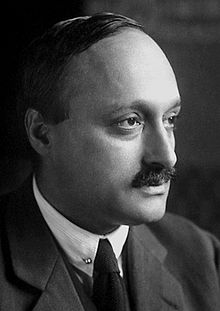
Back James Franck Afrikaans James Franck AN جيمس فرانك Arabic جيمس فرانك ARZ جیمز فرانک AZB Джэймс Франк Byelorussian Джеймс Франк Bulgarian জেমস ফ্রাংক Bengali/Bangla James Franck BS James Franck Catalan
James Franck | |
|---|---|
 Franck in 1925 | |
| Born | 26 August 1882 |
| Died | 21 May 1964 (aged 81) |
| Nationality | German |
| Citizenship | |
| Alma mater | |
| Known for |
|
| Awards |
|
| Scientific career | |
| Fields | Physics |
| Institutions | |
| Thesis | Über die Beweglichkeit der Ladungsträger der Spitzenentladung (1906) |
| Doctoral advisor | |
| Doctoral students | |
James Franck (German pronunciation: [ˈdʒɛɪ̯ms ˈfʁaŋk] ⓘ; 26 August 1882 – 21 May 1964) was a German physicist who won the 1925 Nobel Prize in Physics with Gustav Hertz "for their discovery of the laws governing the impact of an electron upon an atom".[1] He completed his doctorate in 1906 and his habilitation in 1911 at the Frederick William University in Berlin, where he lectured and taught until 1918, having reached the position of professor extraordinarius. He served as a volunteer in the German Army during World War I. He was seriously injured in 1917 in a gas attack and was awarded the Iron Cross 1st Class.
Franck became the Head of the Physics Division of the Kaiser Wilhelm Gesellschaft for Physical Chemistry. In 1920, Franck became professor ordinarius of experimental physics and Director of the Second Institute for Experimental Physics at the University of Göttingen. While there he worked on quantum physics with Max Born, who was Director of the Institute of Theoretical Physics. His work included the Franck–Hertz experiment, an important confirmation of the Bohr model of the atom. He promoted the careers of women in physics, notably Lise Meitner, Hertha Sponer and Hilde Levi.
After the Nazi Party came to power in Germany in 1933, Franck resigned his post in protest against the dismissal of fellow academics. He assisted Frederick Lindemann in helping dismissed Jewish scientists find work overseas, before he left Germany in November 1933. After a year at the Niels Bohr Institute in Denmark, he moved to the United States, where he worked at Johns Hopkins University in Baltimore and then the University of Chicago. During this period he became interested in photosynthesis.
Franck participated in the Manhattan Project during World War II as Director of the Chemistry Division of the Metallurgical Laboratory. He was also the chairman of the Committee on Political and Social Problems regarding the atomic bomb, which is best known for the compilation of the Franck Report, which recommended that the atomic bombs not be used on the Japanese cities without warning.
- ^ "The Nobel Prize in Physics 1925". The Nobel Foundation. Retrieved 16 June 2015.